#i cannot deny that getting stung by this bamf can be deadly under certain circumstances
Explore tagged Tumblr posts
Note
Hi again! So, you've probably heard about it by now, but I saw an article about the possibility of Asian giant hornets having migrated over to the U.S. I clearly have no knowledge on the subject beyond what I read in the article (and that's hardly any basis to form an opinion on lol) and I know that this kind of falls under your realm of expertise, so I was wondering if you might have anymore information to offer and possibly alleviate some anxieties??
Hi there! Yes, it seems it’s been bombarding everyone’s news feeds the past few days. I was actually just asked to talk about it on the radio today. I’ll preface this with the fact that I am not super familiar with the biology of this particular species, though I had heard of it before all of this and it’s heckin cool.
Is this wasp a problem? Potentially, yes. Should we call it a ‘murder hornet’ and use it as fodder for wasp hate everywhere? Absolutely not. If the Asian Giant Hornet is a problem, it’s because it could be invasive, not because it’s a wasp. Let’s break that down.
In its home range, this massive wasp specializes on hunting honeybees. Honeybees in Japan are not our honeybees, they’re an entirely different species, Apis cerana japonica (as opposed to western honeybees, Apis mellifera). Japanese honeybees evolved alongside this species, and they are together part of an ecosystem - giant hornets like this don’t just pop up like Godzilla ready to demolish society, they look and act the way they do because of millions of years of evolution alongside predators and prey and their environment. Their arms race is with the Japanese honeybee, which can tolerate temperatures in excess of 115 degrees Fahrenheit, and they will swarm the infiltrating wasp and cook it alive. This is a unique, special adaptation that came about because these two have been duking it out forever. So that’s step 1. This wasp is not some monstrous thing born of Cthulhu. It has an ecological place. Honeybees over there are perfectly used to it, just another day for them (there’s actually two other giant hornet species that attack hives sporadically as well over there). We just think it looks terrifying because it’s different than what we’re used to, and it amplifies our already-present fears of wasp-shaped creatures.
Step 2.1 The reasons why it could pose a problem in the U.S. Firstly, its sting is dangerous; obviously, its sting is very large and can deliver a lot of venom, and if you’ve seen the Coyote Peterson video on it, it causes long-lasting swelling and pain. One or even a few stings will not severely harm you, but seven, eight, a dozen, could potentially send you to the E.R. with severe inflammation and even renal failure. You’re more at risk from complications from fewer stings if you have pre-existing inflammation or breathing problems, and if you get stung someplace like your neck or face. Most victims, even those who are hospitalized, do make a full recovery. That being said, like any other social wasp we have, you’re only likely to get stung if you accidentally stumble upon a nest and can’t book it out of there fast enough. I cannot vouch for the natural aggressiveness of this species, but given its size, life history, and similarities to related species, I would say that it will probably have a fairly proactive response to disturbance, aka, yes, it absolutely does pose a health risk to humans and this is a valid reason to be concerned.
Step 2.2 The other reason people are worried. This wasp targets honeybees, which most people know are extremely important for our agricultural system. It can decimate whole hives of western honeybees, as they have not evolved the defenses necessary to fend them off. However, I’ve heard things like ‘they’re going to contribute to bee declines!’ and that is simply not the case. Honeybees are not native - they are not an essential part of our ecosystem, only our agricultural one. It will be an economic loss if we start losing honeybee colonies, but honeybees are not the bees that we should be concerned about here in North America. It’s our native bees that are declining at startling rates. These hornets will not attack our native bees, because they don’t build hives! Only a very small percentage of our >3,500 species of native bee live in colonies, and they’re almost all underground and with a tiny fraction of the number of workers that a honeybee colony has (instead of tens of thousands, think, a couple dozen). The rest are totally solitary. Not what this wasp is looking for; it has a search image, it knows how to seek out honeybee colonies and I highly doubt it would recognize bumblebees or sweat bees as prey. The reason why this hornet has the potential to do so much damage in the first place is a classic problem with monocultures; grow (or in this case, raise) too much of one thing in one place, and when a disease or pest comes by, it can easily sweep through the population with high mortality. It’s been recognized for a while now that we rely far too heavily on honeybees for our pollination; concerns over Colony Collapse Disorder sparked these discussions. This whole time, we should have been providing for wild, native bees, by giving them the habitat they need to live alongside us and pollinate our crops. Instead, we’ve pushed them out with monocultures, pesticides, and development, then decided to bring in a non-native species to replace them. This is a setup for disaster. The presence of this new threat should be a wakeup call to change our ways.
Step 3. Do not judge all wasps by this one species. ‘Murder hornet’ is not a term that allows us to discuss this animal objectively. The VAST majority of native wasps are small, stingless species which most of us never notice, yet they perform invaluable ecological services as parasitoids. Our stinging species are still mostly solitary and non-aggressive, and are pollinators and predators on common garden pests. And you know what? Yellowjackets, bald-faced hornets (not a true hornet, actually), paper wasps, the ones people don’t like? They’re beneficial too, for the same reasons as above. They are a crucial part of our ecosystem, and are aggressive only if we threaten their colonies, which contain their young. This introduced species posing risks to us does NOT give us the right to condemn our native species to fear and hatred. Wasps already have a bad rap. Don’t make this fuel for the fire. If this wasp is dangerous, it’s not because it’s a wasp. It’s because it’s an invasive species that lacks the checks and balances of its natural habitat. Invasive species can be plants, fungi, or animals, and just because this one is a wasp doesn’t mean you get to lump all other wasps in with it.
Lastly, I’m already seeing people all over the country start to claim they are seeing this wasp. You are not. Unless you live in Washington, at this time, you’re seeing something else. Let me show you a few, in case you are mistaken:
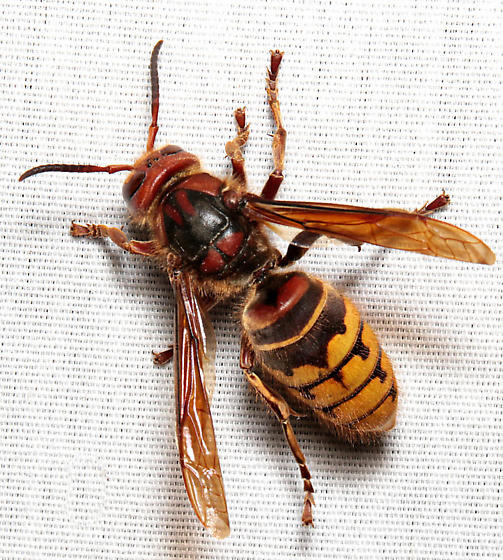
European Hornet - Vespa crabro. (Photo) Non-native, but established in the eastern U.S. Largest wasp most people have ever seen, but still half the size of the queen Asian giant hornet. Acts like other yellowjackets and such, no serious ecological threat.
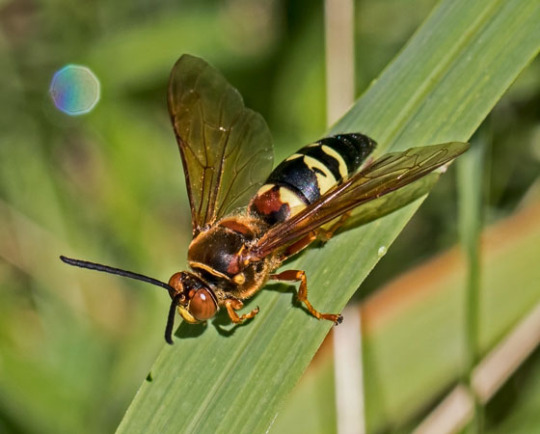
Eastern Cicada Killer - Sphecius speciosus (photo). Native, found east of the Rockies. Specializes on hunting cicadas. A large, solitary wasp, but not aggressive. Lives in burrows in the ground. About the size of the European hornet. They like sandy areas, so you might see them in fields or playgrounds.
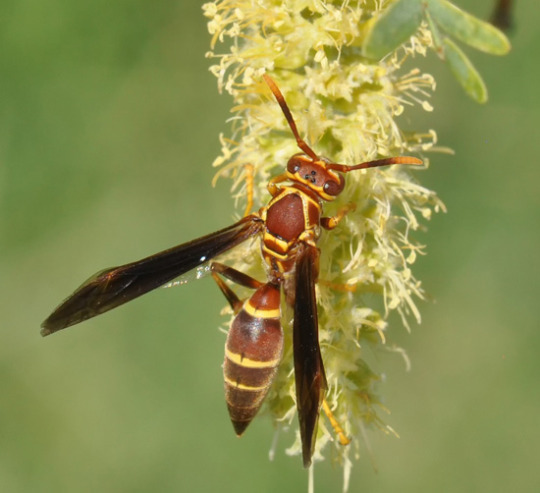
Paper wasps - Polistes spp. (photo). Native, common across the country, some species have yellow markings, others are brown or reddish. Social wasps, they build paper nests under awnings near human habitation, can be somewhat aggressive if you get too close to the nest but otherwise are approachable when foraging on flowers. Smaller, usually 3/4 inch or so.
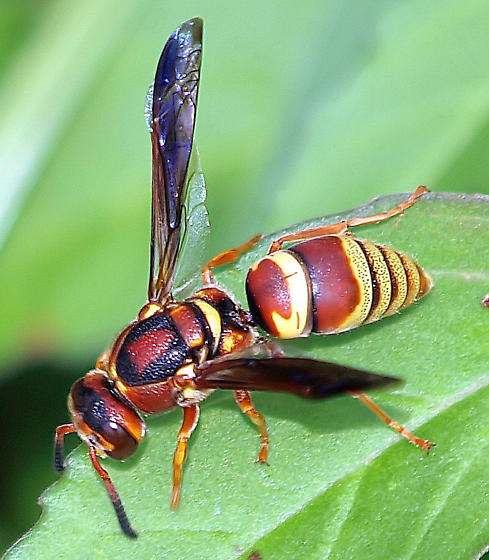
Potter and mason wasps - Eumeninae spp. (photo). We have hundreds of species of potter wasp, and in the southern U.S. many of them have red and yellow markings. This particular one is Euodynerus pratensis from Texas. These are solitary wasps, and are not very large, usually not exceeding 1/2 an inch, maybe the largest are 3/4in. They make mud nests, sometimes near human habitation, but they are docile and rarely cause conflict.
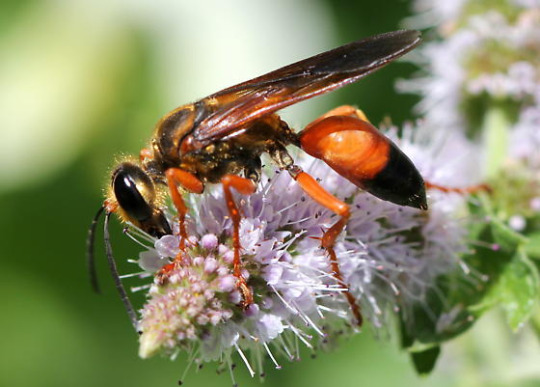
Great Golden Digger Wasp - Sphex ichneumoneus (photo). Common across the U.S., a large native solitary wasp common on flowers. Not really the same body structure as a vespid but just in case... these guys scare some people because they are large and gangly but they hunt grasshoppers and katydids and are generally non-intrusive. They live in underground burrows, not near humans. They’re good pollinators too!
I hope that alleviates some fear that comes with people starting to claim they’re seeing this wasp where it isn’t. It’s just another case of boy cries brown recluse spider. Most people are so unfamiliar with our native insect fauna that once they start noticing wasps, everything looks like the culprit just because they weren’t paying attention to what’s always been around them.
It sounds like they don’t know the extent of establishment yet, or when/how the AGH was introduced. Chances are, if people are starting to find them, then it’s already got a population. However, if early response methods can effectively control their spread, there’s a chance we can eliminate them. We have hundreds of invasive species here in the U.S. that are wreaking havoc on our ecosystems because we missed the short window in which to eradicate them. We do not know the total impact this hornet could have, until we thoroughly read the literature on its ecology back in Asia. It does pose a significant economic risk though, and a human health risk if they end up dwelling near human habitation (which they shouldn’t, I would think, unless you’ve got honeybee hives or feral colonies around). What we’re seeing is two non-natives battling it out - two species that should not be in North America at all. I do hope that we are able to stop this invasion in its tracks, but I also really hope it makes us reconsider the flaws in our agricultural system.
#thehermitreversed#asian giant hornet#wasps#insects#mine#i hope this helps a little?#i cannot deny that getting stung by this bamf can be deadly under certain circumstances#anyone else in this field who knows more about this situation please feel free to chime in!
11 notes
·
View notes